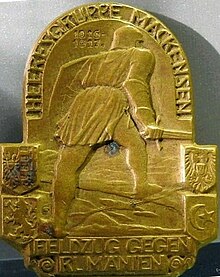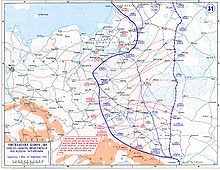Army Group Mackensen
The Army Group Mackensen was an Army Group of the Central Powers in World War I , which was deployed under German leadership in changing composition on various fronts in Eastern and Southeastern Europe and existed from 1915 to 1918.
history
Poland
In the battle of the Carpathians in the winter of 1914/15, the attempt by the Russian army to penetrate the Hungarian lowlands failed. Now the troops of the Central Powers Germany and Austria-Hungary were to start an offensive in southern Poland in April 1915. For the battle of Gorlice-Tarnów , the German Supreme Army Command provided the 11th Army , which was newly established at the beginning of 1915 , and Colonel - General August von Mackensen (previously Mayor of the 9th Army ) was to take over its command . The Austro-Hungarian Army High Command agreed to subordinate 11 Austro-Hungarian troops to the AOK for this purpose. Von Mackensen arrived in the designated area of operations on April 16, where he had the following troops available:
- Guard Corps ( 1st and 2nd Guard Division )
- XXXXI. Reserve Corps ( 81st and 82nd Reserve Divisions )
- X Army Corps ( 19th and 20th Infantry Divisions )
- Corps Kneussl ( 119th Infantry Division and Bavarian 11th Infantry Division )
- kuk VI. Army Corps (Austro-Hungarian 12th Infantry Troop and Austro-Hungarian 39th Honved Division)
- kuk 11th Honved Cavalry Division.
After the briefing by the nominally superior kuk army command in Teschen, he went from Mackensen to Neu Sandez , where the headquarters of the Mackensen army group was set up. De facto von Mackensen already led an army group that consisted of the German 11th Army and the Austro-Hungarian 4th Army (Archduke Joseph Ferdinand ), which followed to the north .
In the course of the advance of the Army Group to the east, the headquarters moved to Jasło (May 9th) and Jarosław (May 27th). Here, after the capture of Przemyśl (June 3), the Austro-Hungarian 2nd Army under Eduard von Böhm-Ermolli (after the dissolution of the right-hand neighboring Austro-Hungarian 3rd Army under Svetozar Boroević von Bojna , also called for further action on Lemberg at the suggestion of Mackensens due to Italy's entry into the war) additionally subordinated to his command.
After the capture of Lviv on June 22nd, for which von Mackensen was appointed Field Marshal General, a regrouping took place for the following Bug Offensive (from June 26th): The Austro-Hungarian 2nd Army, which was set in an easterly direction, withdrew from the Army Group, which was now oriented in a northerly direction. The headquarters of the Army Group moved to Rawa-Ruska (June 30). In addition, the Bug Army ( Alexander von Linsingen ) was formed at the beginning of July , which remained under von Mackensen's orders, and a little later the Austro-Hungarian 1st Army was inserted between the Austro-Hungarian 2nd Army and the 11th Army , which was also temporarily affected by Mackensen's advance on Brest. Litovsk , which fell on August 26th. From August 8th the Army Group Command was in Lublin , and from August 28th in Biała .
Serbia and Macedonia
On September 18, 1915, in the course of the relocation of the Army Group Command from Mackensen to Timisoara, the AOK 11 was disbanded while the subordinate units in the Bug Army / Army Group Linsingen remained . Army Group Mackensen were for the Serbia campaign first the newly formed 11th Army under Max von Gallwitz and the Austro-Hungarian 3rd Army under Hermann Kövess of Kövesshaza , to which was later the Bulgarian 1st Army under Kliment Bojadschiew to come. On September 29th the orders to attack the subordinate armies were issued and on October 6th the campaign began with the crossing over the Danube.
After the fall of Belgrade (October 9) and Bulgaria's entry into the war (October 14), the Serbian army was repulsed on Kragujevac by the end of October . From there she withdrew to Montenegro and Kosovo and Albania in early November . The Austro-Hungarian 3rd Army took over the security of the border, while the German and Bulgarian troops were supposed to take action against the Entente forces that had invaded Macedonia . These could be defeated in December on Vardar , after which the Army Group set up on the Greek border for the winter. An attack on the fortified camp of the Allies in Salonika was planned for the beginning of February 1916, but was later rejected, partly because of the simultaneous offensive against Verdun . The last headquarters of the Army Group in Macedonia was in Skopje . After the Army Group Command had withdrawn in August, the Bulgarian High Command took over the command of the Central Powers there, and later Army Group Below .
Romania
Due to the great battles of 1916 near Verdun , on the Somme and in Galicia , the Central Powers found themselves in an unfavorable position in the summer of 1916. It was to be expected that Romania would soon enter the war on the side of the Entente. Therefore, the chiefs of the German and Austro-Hungarian General Staff and the Bulgarian Colonel Gantschew reached an agreement on July 28 in Pless on joint action in the event of Romania's entry into the war, which was later joined by the Ottoman Empire. A Romanian attack on Transylvania was expected , which was to be answered with an offensive from Bulgaria into Dobruja . Generalfeldmarschall von Mackensen was to be commissioned with their leadership.
On August 28, von Mackensen took over the supreme command of the Bulgarian 3rd Army, some German and Austrian units and the Ottoman VI. Army corps, whose campaign began on the night of September 2nd. Opposite her stood alongside Romanian as well as Russian associations that had been sent to the Dobruja to provide support. Among other things, von Mackensen succeeded in taking the Danube fortresses Tutrakan and Silistra and pushing the enemy back into the Constanța area. The city, which served as a port for the Russian Dobruja troops, was captured on October 22nd, thus creating the conditions for the army group to cross the Danube. To this end, the newly formed Danube Army ( Robert Kosch ) came under the command of the Army Group.
The Danube crossing took place on November 23rd near Swishtow , secured by the Austro-Hungarian Danube Flotilla . By the end of November, the Argeș was reached and the connection with the 9th Army under Erich von Falkenhayn , which was now also subordinate to Mackensen. In the battle of the Argesch (December 1st to 6th) the Romanians were able to be thrown back and Bucharest was subsequently taken. Around Christmas 1916 there was the battle of Rimnicul-Sarat , after which almost all of Wallachia was occupied.
The new year began with the battle of the Putna. On January 8th, Focşani was captured. With this the goals of the OHL were achieved, and the Army Group set up for trench warfare. In the summer of 1917, after the Kerensky offensive, there were again Russian-Romanian attacks, which were repulsed in the Battle of Mărăşti and the Battle of Mărăşeşti until September. These were the last major fighting on the Romanian front. After the October Revolution in Russia, Romania was also forced to seek a ceasefire. This went down in history as the Focşani armistice of December 9, 1917 between the four Central Powers on the one hand and Russia and Romania on the other. After the Treaty of Bucharest on May 7, 1918, Army Group Mackensen was converted into the high command of the occupying army .
guide
- Commander in chief
- Colonel General / Field Marshal August von Mackensen (1915 to 1918)
- Chief of Staff
- Colonel / Major General Hans von Seeckt (from April 1915)
- Major General Gerhard Tappen (from August 1916)
- Colonel / Major General Emil Hell (from December 1916)
- Colonel Friedrich Wilhelm von Schwartzkoppen (from April 1918)
literature
- Austria-Hungary's last war, 1914–1918. Volumes 2 and 3. Published by the Austrian Federal Ministry for National Defense and by the War Archives, Verlag der Militarywissenschaftlichen Mitteilungen, Vienna 1930.
Web links
- Army Group Mackensen on the website of the Federal Archives (PDF; 27 kB)
- Army groups in the east on deutsche-kriegsgeschichte.de
- Army groups in the east on The Prussian Machine



